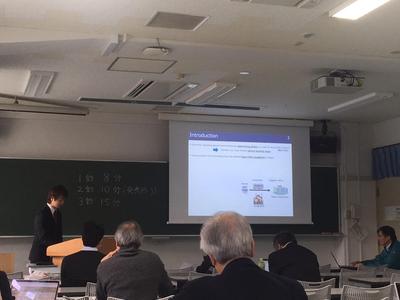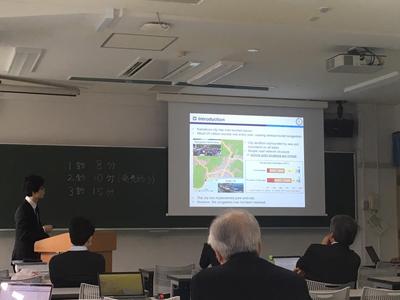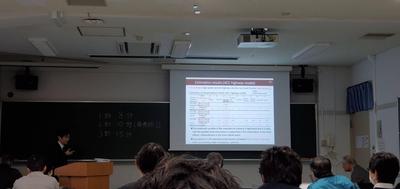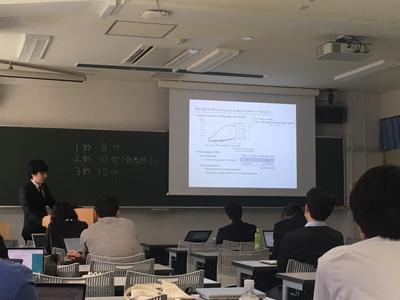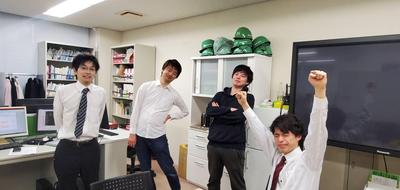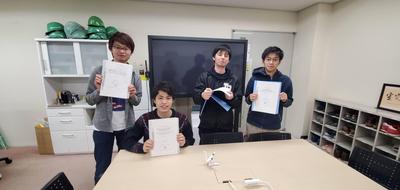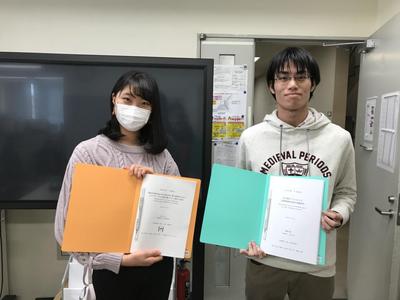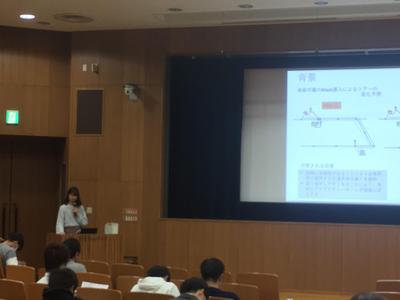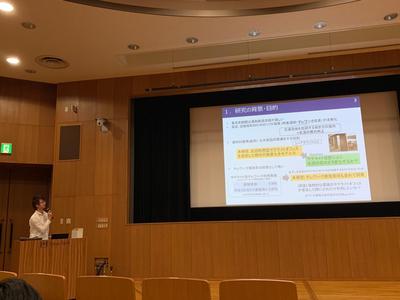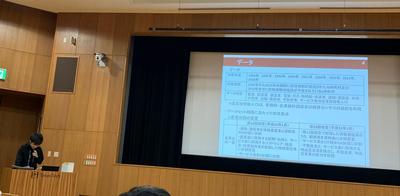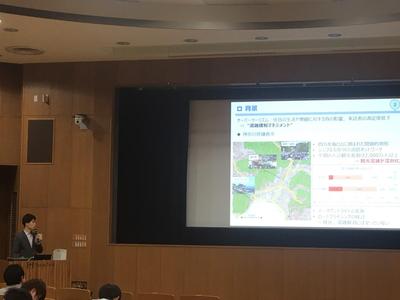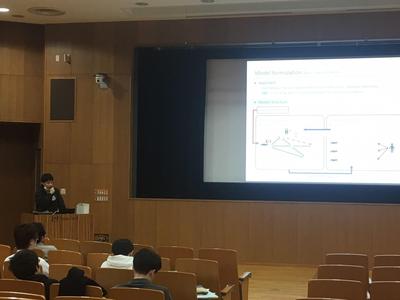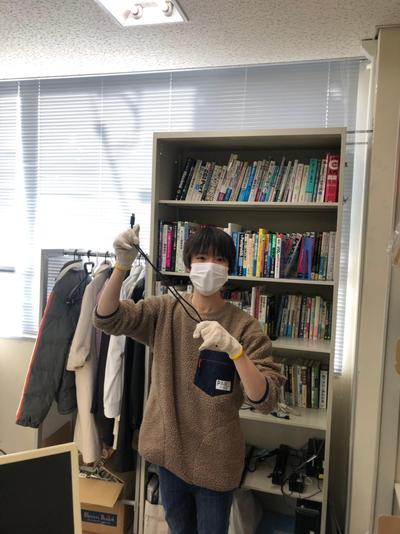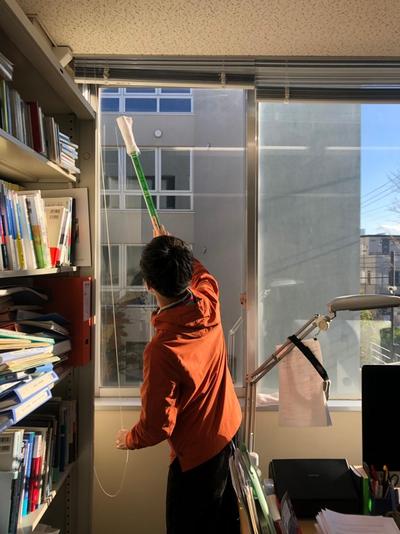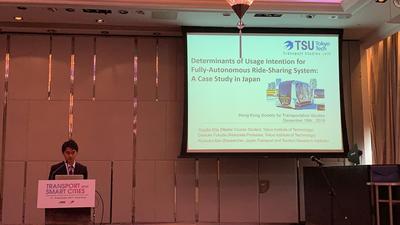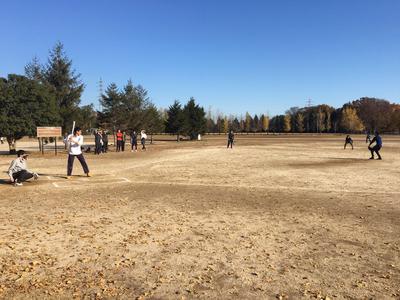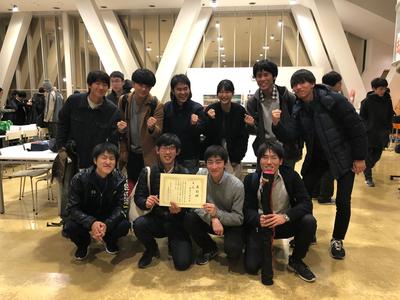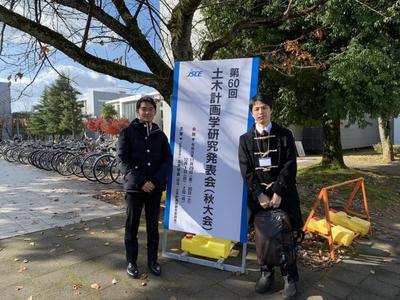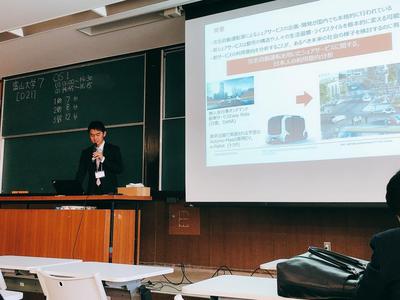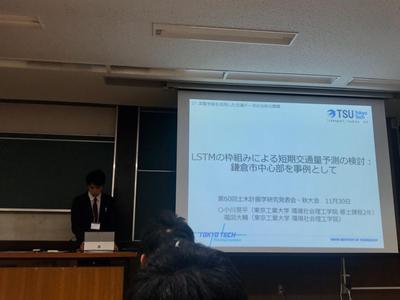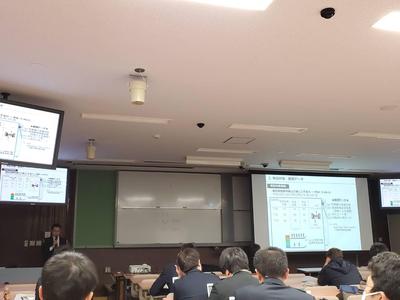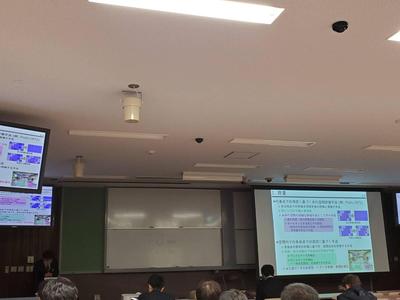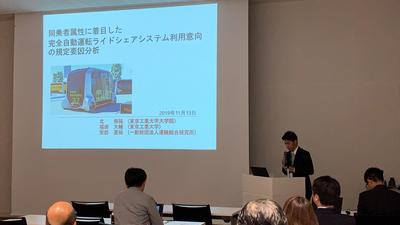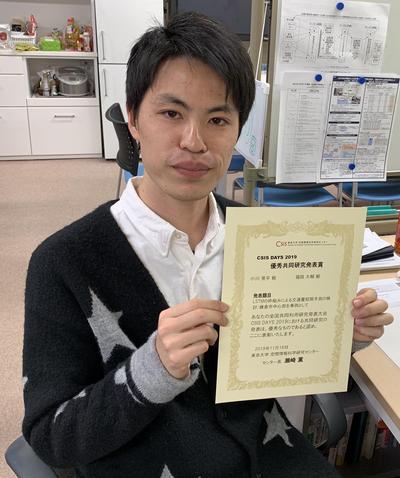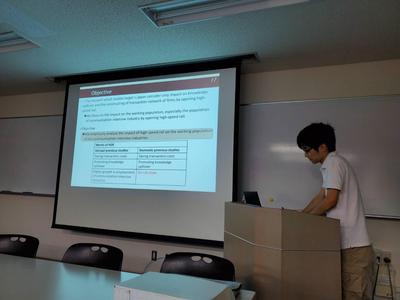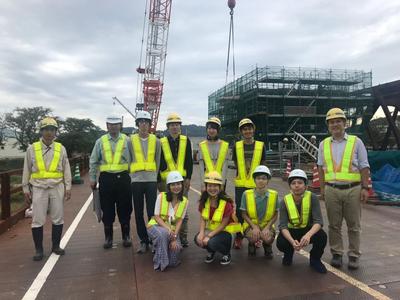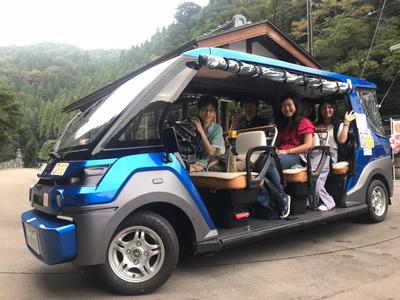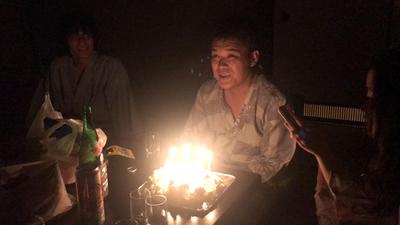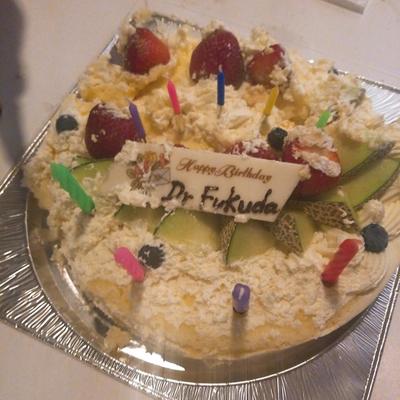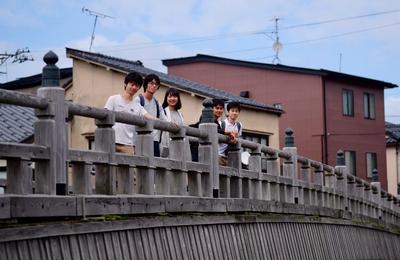Master’s thesis presentation
[2020/2/13]
All the presentations and Q&A sessions were in English, but everyone was able to give their presentations without any problems. Thank you very much for your hard work!
Many of the presenters were not in the planning field, but they asked many questions and had lively discussions.
Thank you very much for your questions.
Submission of the thesis!
[2020/1/31]
Fukuda Lab members have submitted their master’s theses and graduation theses, respectively.
M2 seniors completed submitting their master’s theses on 24th January.
Mr. Ogawa presented a paper titled “A Study on Short-term Tourism Traffic Congestion Prediction Methodology for Utilizing Various Real-time Data: A Case Study of Kamakura City”, in which he developed a model to output predictions of traffic volume and linked travel speeds in the central area of Kamakura City, and conducted a comprehensive study to verify whether the model can be used for short-term tourism traffic congestion prediction. A comprehensive study was conducted to verify whether the model can be operated as a short-term forecasting model for tourist traffic congestion.
Mr. Kawai conducted a research titled “A Study on the Intention of Metropolitan Area Railway Commuters to Use Satellite Telework and Changes in Lifestyle Behavior Patterns” based on an activity-based approach to analyze the possibility of changes in people’s lifestyle and transportation behavior patterns as a result of a policy to establish satellite offices in suburban areas of the metropolitan area. The analysis was based on the activity-based approach. Using this model, he also clarified in which locations in the Tokyo metropolitan area satellite offices could improve the quality of life of commuters.
In the presentation titled “The Influence of the Location of Electric Vehicle Charging Facilities on Route and Vehicle Type Selection,” Mr. Shiroma conducted mathematical modeling of the interdependence between the route selection behavior of electric vehicles and consumers’ vehicle type selection behavior on a road network with charging facilities, using equilibrium concepts from game theory.
In the evaluation of transportation-related investments such as high-speed rail, Mr. Muro noted that although direct benefits such as time-saving benefits have been the main focus of measurement and evaluation, in addition to time-saving benefits, economic effects and benefits in a broader sense have been proposed in recent years, and empirical research on this evaluation is accumulating. In a paper titled “The Impact of High-Speed Rail on Regional Specialization of Industries,” we empirically analyzed how the working population of each industry, which is one of the economic effects and benefits in the broad sense, changes as a result of the construction of high-speed rail.
On 31st January, two B4 students completed the submission of their theses.
Mr. Ukai conducted a laboratory experiment to investigate the applicability of a theoretical model of self-actualizing signals to a real network, and discussed the results of the experiment.
Ms. Tabuchi, in his paper titled “Research on Multimodal Transportation Behavior Model for Evaluating the Introduction of Mobility as a Service (MaaS),” constructed a behavioral model that simultaneously determines the means of transportation and travel space, with a view to evaluating the introduction of MaaS.
He will study abroad in Sydney for about a year. There will be more vacant desks in the lab, and it will be lonely, but he has been wanting to study abroad since he joined the lab last year, so I hope he will do his best and enjoy it! I would like to visit Australia while Mr. Koyada is studying in Sydney (because of the cost of accommodation…www).
Happy new year! Thank you for your continued support in 2020
Happy New Year! This year, I will be the same age as Kei Nishikori, who reached the U.S. finals in tennis.
Although I cannot become the world’s top player like him, I have to devote myself to be a better person. I look forward to working with you again this year.
It is a little late, but I would like to report on the activities of our lab at the end of last year.
On 27th December, the TSU interim presentation was held. The interim presentation is the last presentation for M2 and B4 students before submitting their thesis, and 6 students from Fukuda Lab gave their presentations.
Thank you very much for your hard work.
Six OBs and OGs attended the year-end party. Thank you very much. (I forgot to take a picture of the year-end party…)
Hong Kong Society for Transportation Studies 2019
[2019/12/14-16]
The Hong Kong Society for Transportation Studies 2019 was held in Kowloon, Hong Kong.
It was the first time for both of us to present the research abroad, but we managed to get through the Q&A session without any help from their professors. I don’t know if the questioners really understood our ideas or not, because our English was so poor… (laugh) (laugh).
Mr. Nagasaki, an M1 student who is currently in the Netherlands and also belongs to the Asakura Lab at TSU, flew directly from the Netherlands to Hong Kong to give a poster presentation.
In the center of Hong Kong, there are many Japanese chain restaurants such as Yoshinoya, Don Quijote, and Marugame Seimen, and there is a lot of Japanese language in the city. This was my first time to visit an Asian country. I wonder if it is the same in mainland China, Korea and Taiwan. To be honest, I did not really feel that I was in a foreign country. Although the recent situation in Hong Kong has caused a lot of concern to the people concerned, there were no public rallies or riots during the five days we were there, and it was peaceful. However, there were scars from the riots, such as peeling concrete everywhere, which made us think.
Baseball Tournament among 10 University Planning Labs
[2019/12/10]
Tokyo Tech made a mixed team from TSU’s Fukuda lab, Asakura lab, Muromachi lab, and Yai lab, and 12 people participated. I participated from the Fukuda lab.
We lost miserably…
We were no match for the other universities.
Last year’s baseball tournament had been cancelled due to rain, so everyone except for Mr. Kurokawa, an M2 student at Muromachi Lab, was participating in the tournament for the first time. However, the morning knocking by the other universities (in the first place, what? I was like, “What? ), I realized how naive I was.
In the offense, the opposing team controls a straight ball of about 100km/h(?). Even if the ball flew in front of the opposing team’s pitchers who controlled 100km/h (?) straight pitches, the well-trained (apparently, other universities had practiced a lot) and solid opposing defenders did not make mistakes. On defense, our defenders, who had no experience in baseball, dragged the pitcher down, and we couldn’t get outs very often.
As a result, we finished last in the tournament with a record of 0-5, and will be next year’s organizer. I apologize for increasing the workload of next year’s M1 so much…
I was an amateur baseball player, having played only with a plastic bat and a rubber ball during recess in high school, although I often watched professional baseball games. I wonder why ballplayers all over the country swing that thing day in and day out and don’t get injured… I joined the hardball club at university and played tennis with a lot of energy, so I was able to play infield defense without any problems. I was completely like Yamato in the Hanshin era (laughs).
However, in the world of competition, especially in sports competitions for the general public, I cannot allow myself to end up with nothing to show for it. I’m quite frustrated with my inadequacy right now. There is one year until the next tournament. By next year, I would like to have enough strength to swing a metal bat, learn how to swing a bat a little more, and practice so that I can hit a ball around 100 km/h at the batting center.
When you get hit, you hit back, double payback!
Finally, I would like to express my gratitude to Mr. Kawasaki of the Muromachi Lab M1 who served as a liaison, and to everyone at Tokyo University of Science who managed the conference as the secretary school this year. Thank you very much.
[Kita]
JSCE Fall Conference
[2019/12/10].
Sorry for the late update.
The Fall Conference of the JSCE Committee of Infrastructure Planning and Management was held in Toyama Prefecture from 30th November to 2nd December.
From Fukuda Lab, Mr. Ogawa (M2), Mr. Kita (M1), Mr. Imaoka (M2) and Mr. Hirabayashi (M2), who graduated last year, gave presentations.
Mr. Ogawa gave a presentation titled “A Study of Short-term Traffic Forecasting in LSTM Framework: A Case Study of Central Kamakura City” and I, Kita, gave a presentation titled “An Analysis of Determinants of Intention to Use a Fully Automatic Ridesharing System Focusing on Passenger Attributes”. We both have a presentation at HKSTS coming up soon. We are not satisfied with our presentation and will prepare for the next one.
Mr. Imaoka and Mr. Hirabayashi gave a presentation entitled “Train-Passenger Flow Rate Density in High Frequency Urban Rail Systems” and “Spatial Patterns of Speed-Density Relationship of Pedestrian Flow in Congested Stations”, respectively. It was very enjoyable to meet them both for the first time in half a year since graduation and to hear their stories after they entered the workforce.
I also listened to Ms. Wang (M2), Mr. Ukai (B4) and Ms. Tabuchi (B5). I think it was helpful for my own research activities.
CSIS DAYS 2019
[added in 2019/12/6]
CSIS DAYS 2019 was held in front of the station of the Kashiwa Campus of the University of Tokyo, and Ogawa-san (M2) and Kita-san (M1, I) gave a presentation and a poster session.
I was nervous because it was the first time for me to present my research to the public, but I was able to exchange some opinions about my research in a friendly atmosphere from the start to the end, which was very informative. I will make use of the opinions I received in this activity in my future research. In addition, as I have many research presentations coming up in the next few weeks, I would like to continue to improve how I communicate my ideas and results to others.
I would like to thank Professor Kusakabe of the University of Tokyo for inviting us.
The 6th & 7th lab seminars
The 6th seminar was held on 10/25 and the 7th seminar was held on 10/30.
In the 6th seminar, (M1 students) Mr. Shimizu, Mr. Koyata, and Mr. Kita gave their presentations.
Mr. Shimizu presented the progress of his research on rainy weather and railroad congestion.
Mr. Koyata analyzed the trend of elderly people’s trips based on the Tokyo PT survey.
As a continuation of his graduation thesis, I, Kita, presented my research on the analysis of the intention to use automatic operation from the viewpoint of time value.
In the 7th seminar, (M2 students) Mr. Muro and Ms. Kawai presented their researches.
Mr. Muro presented his plan to introduce a new evaluation method in his research on the effect of Shinkansen maintenance, in addition to the difference-in-differences analysis.
Mr. Kawai presented his research on the possibility of alleviating railroad congestion in the Tokyo metropolitan area by introducing telework, and how he would analyze the results of a questionnaire survey on the intention to implement telework and the results of the Tokyo PT survey.
In fact, the second semester laboratory seminar was presented in English. I think it is a good practice for M2 and B4 students because thesis and dissertation presentations in civil and environmental engineering are given in English. It is a good opportunity for me because I nned to to prepare my overseas research presentation. Let’s improve our English skills together!
[Kita]
We went on a lab trip!!
[2019/10/11~13]
We went to Ishikawa and Fukui prefectures for a 3D2N laboratory trip.
We took the Tokaido Shinkansen and the limited express train “Shirasagi” from Tokyo, and went sightseeing in the Fukui Prefecture on the first day.
In Fukui City, we visited the Hokuriku Shinkansen construction site, which is currently under construction. I had visited the Saikyo Line platform relocation site at Shibuya Station and the Metropolitan Expressway construction site as part of a class before, and it was instructive to learn about the problems unique to regional cities. Thank you very much, Japan Railway Construction, Transport and Technology Agency.
The 3rd – 5th lab seminars
The 3rd, 4th and 5th seminars were held on October 2, October 9, and October 16, respectively.
In the 3rd seminar, (M2 students) Mr. Shiroma and Ms. Kawai gave their presentations.
Mr. Shiroma presented the direction of network analysis using electric vehicles. He aims to combine user equilibrium allocation and vehicle type selection, taking into account the charging cost of electric vehicles.
Mr. Kawai conducted a rehearsal of a web-based questionnaire asking about the intention of teleworking at satellite offices.
In the fourth lab seminar, (B4 students) Mr. Ukai and Ms. Tabuchi presented their researches.
Mr. Ukai presented the reproduction of the model used in his previous research on hunting phenomena.
Ms. Tabuchi will analyze the trip data in the Tokyo metropolitan area obtained from the Tokyo PT survey in 2008 using the Recursive Logit model and study the feasibility of introducing MaaS, etc.
The B4 students have also finalized their plans for their thesis, and it is time for them to get down to serious research work. I know that there will be many difficulties in their first research and thesis writing, but I wish them the best of luck.
In the fifth lab seminar, (M2 students) Ms. Iokura and Ms. Wang presented their papers.
Ms. Wang presented the results of the traffic survey in Ishigaki Island conducted from August to September. I am looking forward to the future analysis.
Ms. Iokura presented her study abroad in Sweden and internship in the Philippines during the past year. It was interesting to hear about the situation of universities and traffic in other countries.
[Kita]
